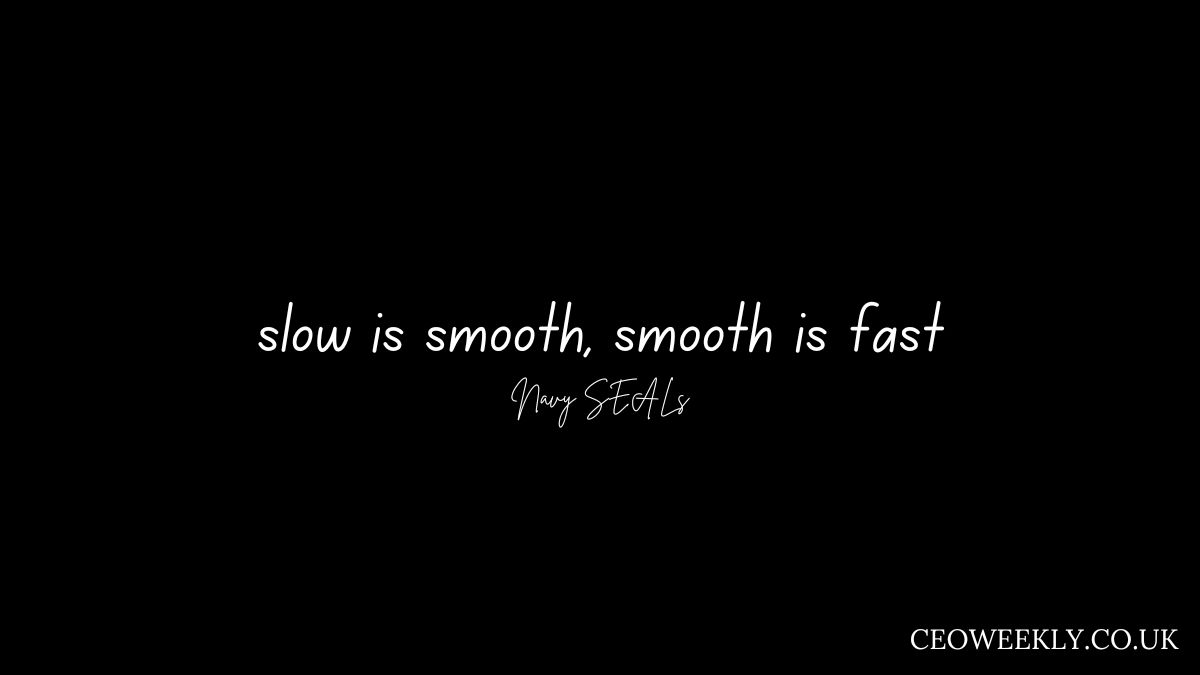Slow is Smooth, Smooth is Fast: Mastering the Art of Efficiency
In today’s emerging worldly life as, global culture paints itself as a swift solution for every cause, no better wisdom goes as the adage states, “slow is smooth, smooth is fast”. This principle borrowed from the military education is common in different fields including business and self-organization, sports and arts. Hence in this article you get more information on this saying, how it can benefit you, and why such a mentality helps you get through doors.
What is ‘Slow is Smooth, Smooth is Fast”?
It is also pertinent to reflect at last on the idea that this paper shall discuss next, the notion of speed; the term ‘slower’ actually means ‘faster.’ However, this concept relates to accurately performed and orchestrated activities that may reduce errors while enhancing organisational effectiveness in the long run. Here’s a closer look:
1. Deaerate Practice: In this way, one does not make so many mistakes as was the case of taking an extra even if it means listening to an explanation regarding a process, a skill, or a technique in the execution of the process or utilization of the skill as well as the technique.
2. Reduced Mistakes: Decisions that occur during tunnel vision are particularly likely to be wrong where the decision is most aggressive. This way it takes less time as you have not done many blunders that would have cost a lot of time when rectified.
3. Building Momentum: After once a particular task or a process has been properly done it increases optimal speed then it decreases the quality of the task.
Practical Applications
1. Personal Productivity
Consequently, it is acknowledged that the modern work setting emphasizes such values as working in pressure and multitasking. However, adopting the “slow is smooth, smooth is fast” approach can improve productivity:
The Big Three should not be employed in places where a person does one thing at a time because carelessness is likely to occur.
Always make sure you try to make your work as qualitative as you can rather than being quantitative.
Do not just get into a specific large agenda and instead make parts of that agenda and then systematically try to take it down.
2. Sports and physical training prospects
When practicing all consumers of sports watch form and technique no matter how fast they are training at. This principle is especially evident in activities like:
Shooting Sports: In due course, the PHI conceptual detailing helps in improving the quick and accurate shots in harmony.
Martial Arts: Performing at a slower speed helps the brain to memorize that movement and increases the rate of performing the movement in the event of incidences.
3. Business Strategy
In business, to decide must be followed by actions without proper planning that leads to failure. Here’s how the principle applies:
They should engage in improved industry analysis before taking a product into the market.
credit for harmonizing goals and objectives in order to support long-term development, rather than a hasty, yet short-lived growth.
Seek to use the most efficient and sustainable process as a strategy of continuing the projects in future.
4. Creative Pursuits
Writers, artists, and musicians often find that slowing down during the creative process leads to better outcomes:
Review and editing make the final product polished at least by going back to the drafts or sketches.
Time to be inspired and time to think results in better ideas created in the organisation.
MUST READ: Understanding HCOOCH CH2 H2O: Chemistry and Applications
Benefits in Achieving the Principal Implementation
1. Improved Accuracy
Lowering the rate worked even lower means that the number of goof ups comes down making the process easier and effective in the longer run.
2. Increased Confidence
Yes of course, as learners develop over the time and progress into executants and reproductions as the practice follows the principles of deliberate practice the certainty with which they act, and the time taken to do so reduces considerably.
3. Long-Term Success
I suppose temporary is 100% effective, though it will not promise major gains – enduring ones are not won quickly and without thinking.
How to practice slow is smooth, smooth is fast in our daily lives
1. Set Clear Goals: Assign purpose to the goals or the objectives for a project before engaging in the project.
2. Embrace Patience: Learn the bitter truth that it does not take one to be successful, but time will do it if put through practice.
3. Focus on Quality: It says that it is important to do a thing right rather than do it right away.
4. Evaluate Progress: You should therefore always look at the approach once in a while and adjust it as perhaps you have been told by others.
Facts and myths of the “Slow is Smart, Smart is Fast” cultural phenomenon
1. What does the phrase “slow is smooth, smooth is fast” actually mean?
The meaning of this phrase is based on the capability of performing tasks with a high degree of precision and within a mannered style without a compromise on productivity. Hence through precision you reduce time you spend on performing activities or chores since you don’t make mistakes.
2. Who coined such a phrase in the first instance?
This is actually a relatively new phrase that has been linked to military exercises such as the U.S. Navy SEALs.
3. Where can I apply this principle in my day-to-day exercising?
This one can be done by having only one thing to do at some period of time, practicing an improvement strategy, and never swearing an activity.
4. Is it ever possible to take it easy when you are busy with a task?
Not at all. As we have also mentioned before, during racing these decisions occur by lack of complete control and make mistakes that will take lots of time in the end to be corrected.
5. Can the application of this principle be used in learning new skills?
Absolutely. The most advantageous thing to note when absorbing new information is that one starts slowing in order that the RAT helps in laying down firm foundations as he masters the art, he does it smoothly at high speed.
Final Thoughts On slow is smooth, smooth is fast
This principle of organization is based on the continued mnemonic of words such as slow and smooth are fast, and smooth is slow the approach underlines patience, and carefulness since it is faster in the long run. In personal aspiration, learning, or artistic endeavour this procedure assures the accomplishment and practicability of ventures in the direction of specific objectives. If one of them decides to apply the principle of working slowly in order to work wisely, he or she will discover the best way of doing things and achieve his or her goals regardless of the time taken.







